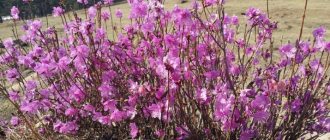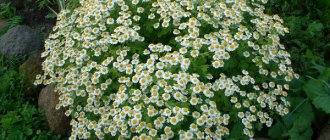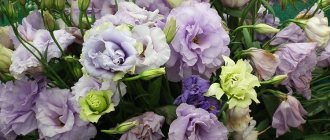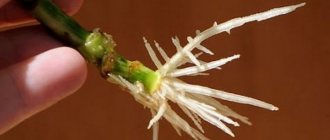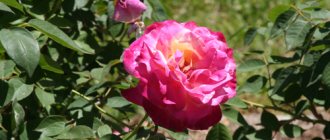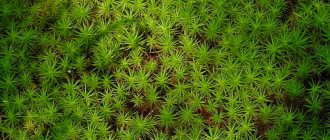The Russian name “bagulnik” comes from the ancient verb “bagulit”, which means “to poison”, and the adjective “bagulny”, forgotten in our time, derived from it, means: poisonous, stupefying, tart, strong. This name reflects the characteristic feature of this shrub - a strong, suffocating odor. The scientific name of wild rosemary is “ledum” (Ledum) comes from the Greek ledon - this is how the ancient Greeks called the plant from which the aromatic resin was extracted - incense (ladanum).
Greenland Rhododendron, or Greenland Ledum. © David A. Hofmann
Description of wild rosemary
Ledum is a genus of plants from the Ericaceae family.
In Western literature, species of the genus Ledum have been included in the genus Rhododendron since the 1990s; in Russian-language untranslated literature, this view of the classification of this genus was not previously supported.
Ledums grow in the cold and temperate zones of the Northern Hemisphere. There are 6 species, 4 of which are common in Russia. Ledum is represented by shrubs and shrubs with evergreen, alternate, entire, leathery, often with a curled edge, leaves.
The leaves and branches of wild rosemary emit a sharp, intoxicating odor, which is explained by the plant’s content of complex essential oil, which has poisonous properties that affect the nervous system and causes dizziness, headache, nausea, vomiting, and sometimes loss of consciousness.
The flowers are bisexual, white, five-dimensional, in umbellate or corymbose inflorescences at the ends of last year's shoots. The wild rosemary fruit is a five-cavity capsule that opens from the base upward. The seeds are very small, winged.
Ledum reproduces by seeds, in culture - by cuttings, layering, dividing bushes and root suckers.
Ledum is often called Daurian rhododendron, the branches of which are sold in winter. But Dahurian rhododendron has nothing to do with wild rosemary.
Daurian rhododendron (Rhododendron dauricum). © kp_arnarb
Contraindications
Due to the strong influence of infusions based on the described culture on the central nervous system, you cannot use drugs on your own. Taking too high a dose causes respiratory paralysis and cardiac arrest.
- Due to the neurotoxin content in the foliage, pollen and nectar of rhododendron, poisoning can occur, the symptoms of which are:
- sweating;
- excessive salivation;
- vomiting and dizziness;
- convulsions;
- sinus bradycardia and too low blood pressure.
- For a number of reasons listed, contraindications are identified in taking appropriate medications for:
- pregnant and lactating women;
- those suffering from an allergic reaction to the flowers of the plant;
- people with chronic kidney diseases;
- children;
- patients with necrosis.
Growing wild rosemary
Planting wild rosemary
The best time to plant wild rosemary is spring. However, if the plant is sold with a closed root system, then planting time does not matter much. Since plants are planted in a permanent place for many years, the planting holes should be 30-40 cm deep, although the bulk of its roots are at a depth of 20 cm. If you want to create a bright spot and wait several years for one specimen to grow, it is not If you have enough patience, plant several bushes, and the distance between plants in the group should be 50-70 cm.
Soil for wild rosemary
Ledums prefer acidic soils. Therefore, the pit is filled with a mixture consisting of high peat, coniferous soil and sand in the proportion (3: 2: 1). Some species can also grow on poor sandy soils. For example, Greenland rosemary and large-leaved wild rosemary, for which the soil mixture is made up of the same components, but with a predominance of sand. Drainage consisting of river pebbles and sand is poured into the bottom of the planting hole with a layer of 5-7 cm. Plantings are mulched.
Ledum. © Wayne Weber
Watering
To maintain an optimal level of soil acidity, it is necessary to regularly (2-3 times a month) water the plantings with acidified water. Feed the bushes once a year in the spring with full mineral fertilizer. In April-May it is enough to scatter 1.5-2 tbsp around the bush. l. fertilizers
Tolerates waterlogging, but does not tolerate drought and soil compaction. Loosening is also desirable, but careful, since due to the root system located near the surface, the roots can be damaged
Caring for wild rosemary
Even though wild rosemaries grow in poor garden soils, they need nutrition to grow well. Therefore, it is important to feed the plants. It is better to do this in the spring, once a season. For feeding, complete mineral fertilizer is used at the rate of 50-70 grams per m2 for each adult plant, for young plantings - 30-40 grams per m2.
In dry and hot summers, wild rosemaries need watering. Therefore, at least once a week they should be watered abundantly with 5-8 liters of water per plant. After which the soil around the bushes can be carefully loosened and mulched with peat to retain moisture. Loosen the soil, as already noted, very carefully, since the roots are located close to the surface of the soil.
Ledums do not need special pruning. To maintain a decorative appearance, only dry and broken branches after winter are pruned.
In cultivation, wild rosemary is resistant to diseases and pests, probably due to its repellent strong odor.
Seedling of wild rosemary. © Laura Black
Reproduction
Reproduction of wild rosemary in a summer cottage is a rather careful task. There are several ways to do this.
They are collected with the coming of autumn. They are collected in specialized hanging boxes. Sowing begins at the beginning of spring. The container is filled with loose earth and sand, and seeds are spread on top of it. Then the containers are sealed with film and kept cool. Care is the same as for any other seedlings.
Propagation of wild rosemary by cuttings is very often practiced. They are prepared in the summer. To activate root formation, they can be kept for 24 hours in a heteroauxin solution (0.01% concentration). It is prepared very simply: the tablet is crushed and dissolved in 2.5 liters of water. Before rooting wild rosemary, the cuttings are washed very thoroughly to remove any remaining preparation and planted in greenhouses. Boxes will also work. Roots take a long time to appear (not until recently than by the next season).
Planting and caring for wild rosemary in your summer cottage will not bring much trouble. In addition to their visual appeal, the bushes will repel mosquitoes and other bloodsuckers. And fresh branches and leaves can be placed in covers with fur products. This is good protection against moths. Essential oils are considered strong antiseptics. Ledum has not been a well-studied plant, so many more pleasant surprises await gardeners.
Using wild rosemary in the garden
Ledums of all types are very graceful and interesting plants. Planted in the garden, they will always decorate it. The smell of fresh leaves and branches of wild rosemary repels blood-sucking insects and protects fur and wool from moths. In addition, they will protect you, because the substances secreted by their leaves kill bacteria harmful to humans. And who knows, perhaps in the near future medicine will thank nature for the creation of this “insidious” shrub and forgive its intoxicating properties.
Attention! During flowering, it releases substances into the air that in large quantities have an adverse effect on humans (headache). Not only the plant itself is poisonous, but also the honey collected from its flowers (the so-called “drunk” honey, which cannot be eaten without boiling). Therefore, although some authors classify this plant as an ornamental one, you should think about whether it is worth growing it in a heather garden or not.
Greenland rosemary. © J Brew
Superstitions and signs
There are many legends about wild rosemary, and there are many superstitions and signs. In this regard, most flower growers do not dare to decorate their home with it. However, this plant is quite useful: it helps to improve the health of the body and cleans the air of pathogenic microbes. But be careful, because if the bush is in the room during flowering, then all the people living there will experience severe headaches. This is connected with the sign that because of this plant, household members become irritable, nervous and begin to have various problems. However, if you leave a few flowers on the bush, it will be able to cleanse the house of negative energy.
Medicinal properties of wild rosemary
Plants contain a whole complex of active substances, which determines the versatility of their effects on the body as a whole. Therefore, it is very difficult to divide plants into expectorants, antitussives, bronchodilators, etc. Among the people, wild rosemary is considered almost a universal medicine. It has antispasmodic, expectorant, diaphoretic, diuretic, disinfectant, analgesic, narcotic and sedative properties, and has diuretic and antimicrobial activity.
Attention! The plant is poisonous. Self-medication can lead to complications and even danger to life.
In folk medicine, wild rosemary is used for respiratory diseases; bronchitis, tracheitis, laryngitis, pneumonia, influenza, bronchial asthma, cough, whooping cough, wounds, as well as snake and insect bites. Copes well with stomach diseases, dysentery, spastic enterocolitis. It is also used in the treatment of liver diseases, fever, cystitis, pyelitis, urethritis.
It is widely used in the form of baths and lotions for the treatment of external diseases (wetting eczema, frostbite, boils, scabies), eye diseases, chronic rheumatism, gout, osteochondrosis, arthritis. It has a positive effect on tuberculosis, diabetes and cancer.
Ledum shoots are used in the form of an infusion as a means of dilating blood vessels, improving blood circulation, and for insomnia. The ability of wild rosemary to moderately reduce blood pressure has been revealed. Patients tolerate wild rosemary well even with long-term use; it does not cause acute toxic effects.
The drug ledin is commercially produced from wild rosemary shoots as an antitussive and bronchodilator. Ledum essential oil has narcotic properties, which are used in the production of beer and vodka.
Why, first of all, are we talking about the respiratory organs? Essential oils of wild rosemary (anise, elecampane, mint, pine buds) are very effective on the mucous membranes of the respiratory tract. Folk and clinical experience of using wild rosemary for the treatment of respiratory organs is very rich.
Chemical composition
The marsh rosemary is a completely poisonous shrub; the flowers, leaves and branches themselves contain essential oils, which determine its specific smell. The oils contain:
- up to 70% - sesquiterpene alcohols, the main one being ice;
- flavonoids;
- tannins;
- neomertillin.
In addition to these basic substances, shoots contain minerals, enzymes, amino acids, vitamins and other useful substances. Our scientists noted that even with long-term use of wild rosemary-based drugs, they are not addictive, so for some diseases they can be used for a fairly long period of time.
Types of wild rosemary
Swamp wild rosemary (Ledum palustre, or Rhododendron tomentosum)
Marsh wild rosemary is widespread in nature and is most often found in cultivation. People call it: bagun, bagula, bagunnyak, bogovnik, bagunnik, bugun, swamp hemlock, gologolovo, bagno, oregano, oregano, kanabornik, swamp canaber, large bug grass, bog grass, swamp stupor, forest rosemary.
Homeland of Ledum swamp Arctic, East European Plain, Western and Eastern Siberia, Western, Northern, Southern Europe, Northern Mongolia, Northeastern China, Korea, North America. It grows in the tundra and forest-tundra on peat bogs, in high bogs, in the undergrowth of damp coniferous forests, along mountain rivers and streams, in the highlands, in groups, in small thickets, among dwarf cedar trees.
Ledum palustre. © Raino Lampinen
Marsh wild rosemary is a highly branched evergreen shrub from 50 to 120 cm high, with ascending shoots covered with thick “rusty” tomentose. The diameter of the bush in adulthood is about 1 meter. The leaves are lanceolate, dark, shiny, fragrant. The edges of the leaves are strongly curled down. Flowers (up to 1.5 cm in diameter) are white, less often pinkish, sharp-smelling, in multi-flowered umbels (May-June). The capsule fruit opens with five doors. The seeds ripen in mid-August. The roots are superficial, with mycorrhiza.
Greenland Ledum (Ledum groenlandicum)
The natural habitat of Greenland Ledum is the northern and western part of North America. Grows in peaty bogs. Rare in culture, mainly in the collections of botanical gardens in St. Petersburg, Riga, Canada, USA, Germany and Switzerland.
Greenland Rhododendron, or Greenland Ledum (Ledum groenlandicum). © Meggar
Currently, in taxonomy, the species is known as Greenland Rhododendron (Rhododendron groenlandicum). Previously, the species was classified as a member of the genus Ledum and its name was Greenland Ledum (Ledum groenlandicum), in Russian-language literature the species is known under this name.
Greenland Ledum is a shrub up to 1 meter high, with oblong leaves (up to 2.5 cm long), white flowers (up to 1.5 cm in diameter), collected in an umbrella-shaped inflorescence. Blooms from mid-June to the second decade of July. The seeds ripen by the end of September. Growth is moderate. From the end of July until autumn frosts, there are cases of secondary growth due to which, probably, the ends of young shoots do not have time to completely lignify and freeze slightly. However, this does not affect the decorative appearance.
Creeping Ledum or Prostrate Ledum (Ledum decumbens)
Homeland of Ledum creeping: Eastern Siberia, Far East: Chukotka, Kamchatka, Okhotia, Sakhalin, northern part of North America, Greenland. It grows in shrub tundras on hummocks with open forests, on sandy hills, loaches, in thickets of dwarf cedar, in high-mountain sphagnum bogs, and rocky placers.
Creeping Ledum, or prostrate Ledum (Ledum decumbens). © dimorfant
Evergreen shrub 20-30 cm tall. It does not bloom profusely, but annually from the second ten days of May to mid-June. Fruits irregularly. The seeds ripen at the end of August. Grows slowly, annual growth is about 1 cm.
Ledum macrophyllum
Homeland of Ledum largeleaf: Eastern Siberia, Far East: Sakhalin, Primorye, Amur River basin; northern part of Korea, Japan (Hokkaido). It grows in the undergrowth of mountain coniferous forests, in sphagnum bogs, along the edges of stone placers among thickets of heather shrubs.
Tolmacheva's rhododendron, or large-leaved wild rosemary (Ledum macrophyllum). © Ross Bayton
Large-leaved wild rosemary, described by A.I. Tolmachev in 1953, is considered a synonym of the species Rhododendron tolmachevii.
Large-leaved wild rosemary is an evergreen shrub up to 1.3 m tall. It blooms profusely, from the second half of May to the first ten days of June. The seeds ripen in late August - early September. Annual growth is 3-4 cm, rarely 6-8 cm.
